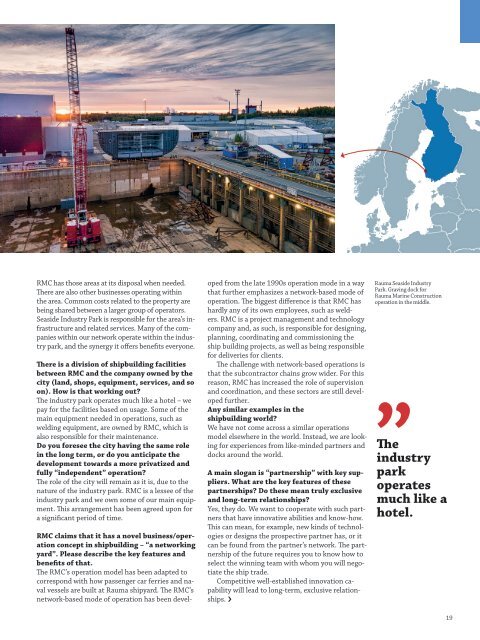You also want an ePaper? Increase the reach of your titles
YUMPU automatically turns print PDFs into web optimized ePapers that Google loves.
RMC has those areas at its disposal when needed.<br />
There are also other businesses operating within<br />
the area. Common costs related to the property are<br />
being shared between a larger group of operators.<br />
Seaside Industry Park is responsible for the area’s infrastructure<br />
and related services. Many of the companies<br />
within our network operate within the industry<br />
park, and the synergy it offers benefits everyone.<br />
There is a division of shipbuilding facilities<br />
between RMC and the company owned by the<br />
city (land, shops, equipment, services, and so<br />
on). How is that working out?<br />
The industry park operates much like a hotel – we<br />
pay for the facilities based on usage. Some of the<br />
main equipment needed in operations, such as<br />
welding equipment, are owned by RMC, which is<br />
also responsible for their maintenance.<br />
Do you foresee the city having the same role<br />
in the long term, or do you anticipate the<br />
development towards a more privatized and<br />
fully “independent” operation?<br />
The role of the city will remain as it is, due to the<br />
nature of the industry park. RMC is a lessee of the<br />
industry park and we own some of our main equipment.<br />
This arrangement has been agreed upon for<br />
a significant period of time.<br />
RMC claims that it has a novel business/operation<br />
concept in shipbuilding – “a networking<br />
yard”. Please describe the key features and<br />
benefits of that.<br />
The RMC’s operation model has been adapted to<br />
correspond with how passenger car ferries and naval<br />
vessels are built at Rauma shipyard. The RMC’s<br />
network-based mode of operation has been developed<br />
from the late 1990s operation mode in a way<br />
that further emphasizes a network-based mode of<br />
operation. The biggest difference is that RMC has<br />
hardly any of its own employees, such as welders.<br />
RMC is a project management and technology<br />
company and, as such, is responsible for designing,<br />
planning, coordinating and commissioning the<br />
ship building projects, as well as being responsible<br />
for deliveries for clients.<br />
The challenge with network-based operations is<br />
that the subcontractor chains grow wider. For this<br />
reason, RMC has increased the role of supervision<br />
and coordination, and these sectors are still developed<br />
further.<br />
Any similar examples in the<br />
shipbuilding world?<br />
We have not come across a similar operations<br />
model elsewhere in the world. Instead, we are looking<br />
for experiences from like-minded partners and<br />
docks around the world.<br />
A main slogan is “partnership” with key suppliers.<br />
What are the key features of these<br />
partnerships? Do these mean truly exclusive<br />
and long-term relationships?<br />
Yes, they do. We want to cooperate with such partners<br />
that have innovative abilities and know-how.<br />
This can mean, for example, new kinds of technologies<br />
or designs the prospective partner has, or it<br />
can be found from the partner’s network. The partnership<br />
of the future requires you to know how to<br />
select the winning team with whom you will negotiate<br />
the ship trade.<br />
Competitive well-established innovation capability<br />
will lead to long-term, exclusive relationships.<br />
›<br />
Rauma Seaside Industry<br />
Park. Graving dock for<br />
Rauma Marine Construction<br />
operation in the middle.<br />
”The<br />
industry<br />
park<br />
operates<br />
much like a<br />
hotel.<br />
19

















